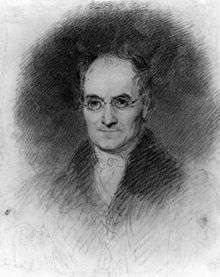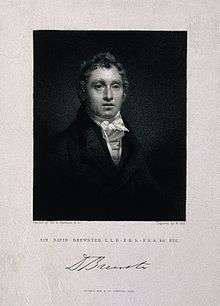William Holl the Elder
William Holl, the elder (1771–1838) was an English engraver, thought to be of German background, and a political radical.

Life
Holl was a pupil of Benjamin Smith the engraver, and worked in the stipple method.[1] He was noted as an exponent of "chalk manner" engraving, based on the simulation of chalk lines on paper.[2][3] While with Smith, he had Thomas Uwins as unwilling pupil.[4]
A progressive in politics, Holl at the time of the Spa Fields riots in December 1816 took the risk of concealing James Watson, son of James Watson (1766–1838) the radical leader, and aiding his departure for the USA. He was a pioneer in using steel plates for banknotes,[1][5]
Holl lived in Bayham Street, Camden Town.[6] He died in London, 1 December 1838.
Works

Holl was noted for his numerous engraved portraits, some being for Edmund Lodge's Portraits of Illustrious Personages of Great Britain. He was employed in engraving Henry Corbould's drawings of the antique marbles in the British Museum, and engraved, among other subjects, The Boar which killed Adonis brought before Venus, after Richard Westall. Holl did not push himself forward, and his work often appeared under the name of others.[1]
In the 1820s, Holl was one of the early adopters of the steel plate engraving technique pioneered by Charles Warren; others in the field were William Thomas Fry and Charles Marr.[7]
Family
Holl married Mary Ravenscroft, and they had four sons who followed his trade: Benjamin, who practised engraving for a short time; William; Francis, A.R.A.; and Charles (died 1882), who also practised as an engraver.[1][5] Another son was Henry Holl the actor.[6]
Notes
- Lee, Sidney, ed. (1891). . Dictionary of National Biography. 27. London: Smith, Elder & Co.
- Mark Bills; Peter Funnell; Jane Sellars; Barbara Bryant (24 September 2013). Frank Holl: Emerging from the Shadows. Philip Wilson Publishers. p. 55. ISBN 978-1-78130-016-9.
- "National Gallery of Art - Colorful Impressions: The Printimaking Revolution in Eighteenth-Century France". Retrieved 23 February 2016.
- Owens, Felicity. "Uwins, Thomas". Oxford Dictionary of National Biography (online ed.). Oxford University Press. doi:10.1093/ref:odnb/28047. (Subscription or UK public library membership required.)
- Chapman, Hilary. "Holl family". Oxford Dictionary of National Biography (online ed.). Oxford University Press. doi:10.1093/ref:odnb/13512. (Subscription or UK public library membership required.)
- Henry Benjamin Wheatley; Peter Cunningham (24 February 2011). London Past and Present: Its History, Associations, and Traditions. Cambridge University Press. p. 131. ISBN 978-1-108-02806-6.
- Basil Hunnisett (1980). Steel-Engraved Book Illustration in England. David R. Godine. p. 24. ISBN 978-0-87923-322-8.
| Wikimedia Commons has media related to William Holl. |
Attribution
![]()